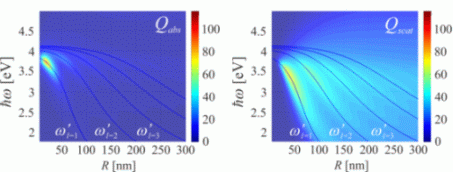
Optimisation of Spectral Efficiency of Gold and Silver Nanoparticles for Bio-sensing Applications; Size Dependence of Plasmon Resonance Frequencies and Damping Rates
Noble metal nanoparticles (NPs) offer a variety of exciting possibilities in diagnostic and sensing applications. Resonant excitation of localized surface plasmons (LSP) in NPs give rise to a variety of effects, such as frequency dependent absorption and scattering as well the enhancement of the electric near-field. Sensitivity of LSP resonance frequency to the refractive index of the immediate environment and particle size is the basis for biochemical sensing or colorimetry. Plasmon enhanced electromagnetic fields are applied in surface-enhanced Raman spectroscopy (SERS), near-field microscopy and in high-sensitivity bio-sensing. Tailoring LSP characteristics and the manner they manifest in the spectra is of fundamental importance to such applications [1].

Understanding the fundamentals of resonant interaction of light with plasmonic nanoparticles is essential for studying LSP properties and for their optimal use. Direct plasmon characterization in terms of multipolar plasmon resonance frequencies (PRFs) and radiative and nonradiative damping rates (DRs) versus NPs size [2-4] allows deeper understanding of LSP features and greatly facilitates the optimisation of LSP in applications. We give direct size characteristics of PRFs and DRs for gold and silver NPs of diameter up to the 600nm in various environments, and discuss the manner their manifest in the absorption and scattering efficiencies spectra (see Figure, Ag NP). Our study can serve as a handy practical tool for predicting the spectral performance of single or colloidal nanoparticles, in estimation of the shift of plasmon resonances in colorimetric probes, or adjustment of the plasmon resonance frequency to the desired molecular transition.
References
[1] K. Kolwas, A. Derkachova, D. Jakubczyk, Book chapter in “Nanomedicine and Tissue Engineering, State of the Art and Recent Trends”, Apple Academic Press 2015,
[2] K. Kolwas, A. Derkachova, J.Q.S.R.T., 114, 45 (2013),
[3] K. Kolwas, A. Derkachova, Opto-Electr. Rev. 18(4) 429 (2010),
[4] K. Kolwas, A. Derkachova, M. Shopa, J.Q.S.R.T. 110 1490 (2009).
Krystyna.Kolwas@ifpan.edu.pl
Powered by Eventact EMS